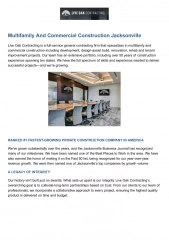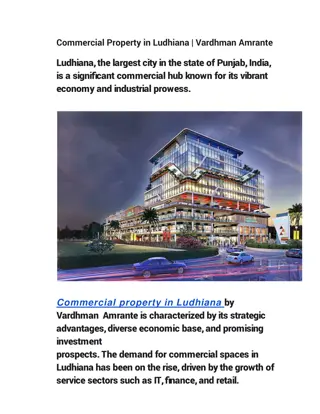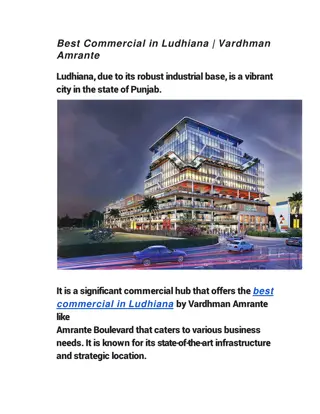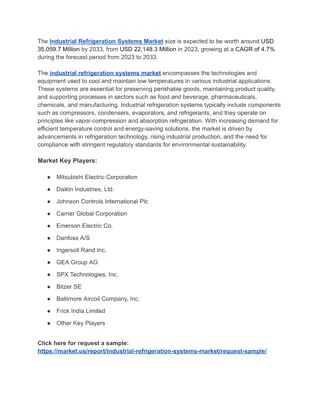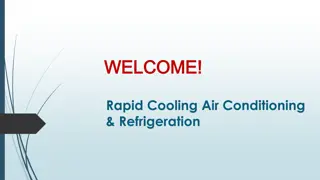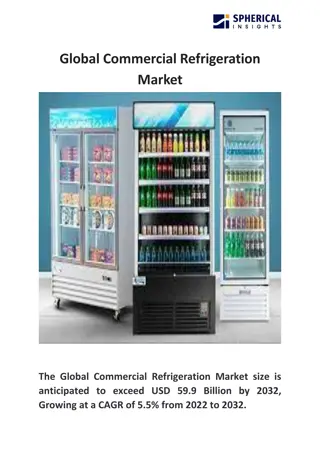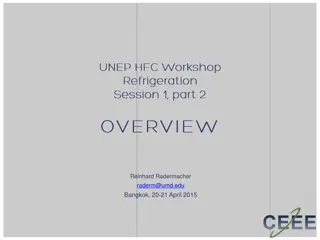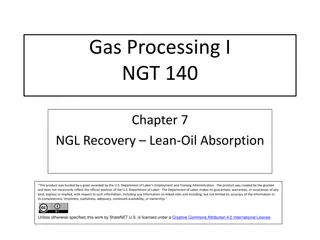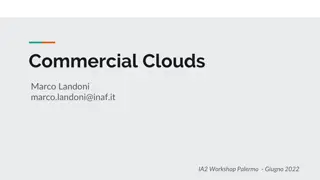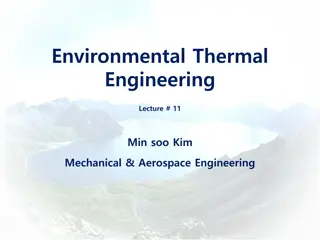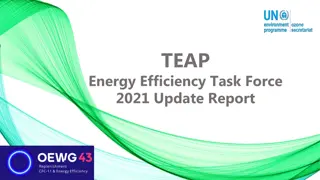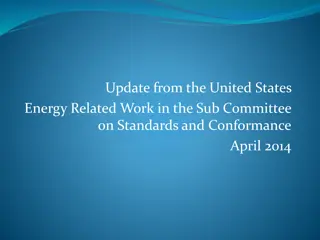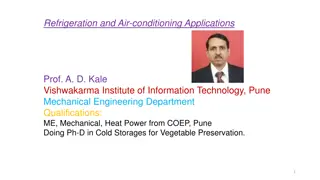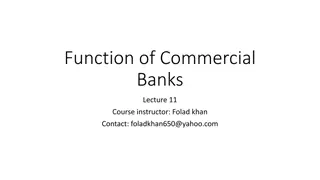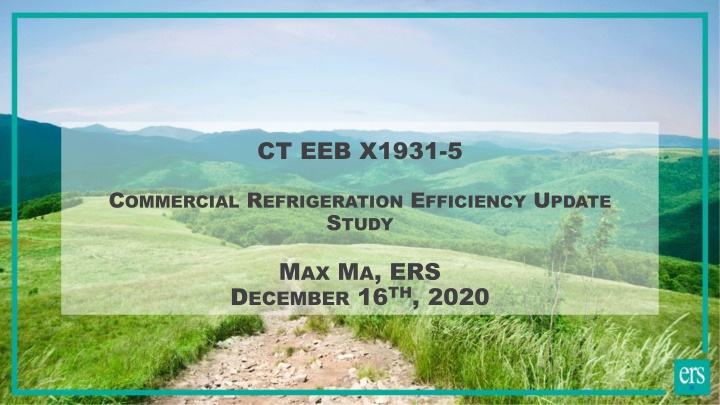
Commercial Refrigeration Efficiency Study Update
This study aims to update commercial refrigeration efficiency values through primary research, including literature review and data aggregation. It focuses on updating Coefficient of Performance (COP) and Annualized Coefficient of Performance (ACOP) values for coolers and freezers. The research also seeks to recommend an approach to quantify HVAC interactive savings for refrigeration measures, considering heating and cooling interactive factors based on HVAC equipment type and condenser location. The detailed tasks involve reviewing manufacturer databases, interviewing industry experts, and analyzing nameplate data from recent studies in Connecticut. Virtual on-site visits to facility owners/operators will also be conducted to gather essential information.
Download Presentation

Please find below an Image/Link to download the presentation.
The content on the website is provided AS IS for your information and personal use only. It may not be sold, licensed, or shared on other websites without obtaining consent from the author. If you encounter any issues during the download, it is possible that the publisher has removed the file from their server.
You are allowed to download the files provided on this website for personal or commercial use, subject to the condition that they are used lawfully. All files are the property of their respective owners.
The content on the website is provided AS IS for your information and personal use only. It may not be sold, licensed, or shared on other websites without obtaining consent from the author.
E N D
Presentation Transcript
CT EEB X1931-5 COMMERCIAL REFRIGERATION EFFICIENCY UPDATE STUDY MAX MA, ERS DECEMBER 16TH, 2020
2 AGENDA Study Background Study Objectives and Approach Detailed Tasks Schedule and Budget
STUDY BACKGROUND C&I measures involving interactive refrigeration savings currently use outdated efficiency Coefficient of Performance and Annualized Coefficient of Performance (COP and ACOP) values. These values are derived from the 2009 ASHRAE Handbook and experience from submitted projects. Measures currently utilizing COP and ACOP LEDs in refrigerated spaces Adding case doors Evaporator fan EC motors Evaporator fan controls Potential measures that could utilize COP and ACOP in future revisions Door heater controls Cooler night covers Target facilities are grocery stores, convenience stores, restaurants, cafeterias etc, excluding warehouses and industrial processes. Refrigeration measures do not further consider potential HVAC interactivity. HVAC interactivity applicable where condensers are located in cooled and heated spaces, e.g. restaurants and space-constrained school kitchens 3
STUDY OBJECTIVES This study focuses on two research objectives: The first objective of this research is to update aggregate commercial refrigeration efficiency values through primary research, including literature review, aggregating recent field data and outreach to refrigeration operators. Update COP and ACOP values for coolers and freezers, respectively, which are used in current CT PSD algorithms for the four impacted measures The second objective of this research is to recommend an approach to quantify HVAC interactive savings for measures with refrigeration savings. Calculate heating and cooling interactive factors based on HVAC equipment type at each facility and condenser location 4
DETAILED TASKS Task 1: Review of Manufacturers Databases ERS will identify the manufacturers of commercial refrigeration systems most commonly installed in Connecticut. ERS will compile data from a minimum of four manufacturers. The planned data collection will include: Nameplate voltage, amperage, phase, power factor, or real power Nameplate refrigeration capacity Performance data if available (% power at % load, or similar) Task 2: Interview with Industry Experts ERS will identify and interview a minimum of four refrigeration industry experts who are familiar with commercial installations and operations in Connecticut. The planned data collection will include: Typical refrigeration efficiency for currently installed systems Typical refrigeration efficiency for new systems Factors affecting refrigeration efficiency Age/degradation Facility type Condenser location 5
DETAILED TASKS Task 3: Review of Nameplate Data from Recent Connecticut Studies ERS will review studies conducted in Connecticut within the past 5 years that included refrigeration nameplate information. ERS will extract the following information from the relevant studies (where available): Nameplate voltage, amperage, phase Nameplate refrigeration capacity Condenser locations whether mechanically cooled Task 4: Virtual On-Site Visits to Facility Owners/Operators ERS will reach out to a minimum of 10 owners and operators of facilities with commercial refrigeration systems, and conduct virtual site visits to collect the following information: Nameplate voltage, amperage, phase Nameplate refrigeration capacity Condenser locations whether mechanically cooled Age, degradation, maintenance and other operational challenges that may impact efficiency 6
DETAILED TASKS Task 5: Analysis Using information collected from Tasks 1 through 4, ERS will: Calculate average COP and ACOP values using data from each task averaging values with removal of data anomolies Recommendations for updating the COP and ACOP values in the CT PSD (one set of values for coolers and one set for freezers), including the following measures: LEDs in refrigerated spaces, Adding case doors, Evaporator fan EC motors, Evaporator fan controls Recommend measures for inclusion of HVAC interactive factors, including: HVAC factor if condenser is in a space known to be conditioned HVAC factor if condenser location is unknown Any other factors impacting refrigeration efficiency, such as: Aging Degradation Task 6: Reporting Draft and final summary report Final powerpoint presentation of results and recommendations 7
8 SUMMARY OBJECTIVESAND OUTCOMES Objective Method Outcome Update COP and ACOP values Review of Manufacturers Databases Interview with Industry Experts Review of Nameplate Data from Recent Connecticut Studies Virtual On-Site Visits to Facility Owners/Operators Averaging COP and ACOP values within each data collection task Recommend updated values for COP and ACOP, one set for coolers and one set for freezers, for the following measures: LEDs in refrigerated spaces, Adding case doors, Evaporator fan EC motors, Evaporator fan controls Quantify HVAC heating and cooling interactive factors resulting from commercial refrigeration measures Recommend HVAC heating and cooling interactive factors for: If condenser location is known to be heated/cooled If condenser location is unknown Review of Manufacturers Databases Review of Nameplate Data from Recent Connecticut Studies Virtual On-Site Visits to Facility Owners/Operators Assigning a heating and cooling efficiency for each data point based on system type (0 for condensers not located within building envelope) Averaging heating and cooling factor within data collected from each task
SCHEDULEANDBUDGET December 2020 Study kickoff February 2021 Complete data collection April 2021 Finalize analysis May 2021 Final report and presentation Reports finalized for June PSD update Estimated Budget $29.6k Task Literature Review Interviews and Data Collection Analysis Reporting and Presentation Total Cost $4,300 $15,400 $5,200 $4,700 $29,600 9
10 THANK YOU
CONTACT US Max Ma, Senior Engineer mma@ers-inc.com 978-332-5832 www.ers-inc.com ERS is an energy and engineering consulting firm providing services in energy efficiency customer engagement, implementation, evaluation, both pre- and post-installation M&V, custom feasibility studies, and distributed and renewable generation assessment.

